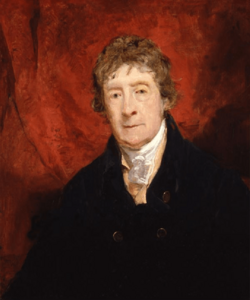William "Gentleman" Smith facts for kids
Quick facts for kids
William Smith
|
|
|---|---|

A portrait of Smith by John Jackson c. 1819, in the National Portrait Gallery in London.
|
|
| Born | 1730 London
|
| Died | 13 September 1819 |
| Other names | William "Gentleman" Smith |
| Occupation | Actor |
| Years active | 1753–1758 |
| Spouse(s) | Kelland Courtnay (?Elizabeth Montagu) Miss Newson |
William Smith (born 1730 – died 1819) was a very famous English actor. People called him "Gentleman Smith" because of his polite and elegant style. He lived in the 1700s and worked with other great actors like David Garrick.
Smith was the first actor to play the role of Charles Surface. This character is from a well-known play called The School for Scandal. It was written by Richard Brinsley Sheridan.
Contents
The Life of William Smith
Early Years and Education
William Smith was born in London in 1730. His father wanted him to become a church leader. So, he sent William to Eton College in 1737. Later, in 1748, William went to St John's College, Cambridge.
William was known for being very lively and energetic. This sometimes got him into trouble at Cambridge. He decided to leave the university before finishing his studies. He wanted to follow his dream of becoming an actor.
Starting His Acting Career
After leaving Cambridge, William Smith moved to London. He wanted to act on stage. In January 1753, he got his first role at the Covent Garden Theatre. He played Theodosius in a play called The Force of Love. Many of his friends from college came to support him.
He then took on other roles. These included Polydore in The Orphan and Dolabella in All for Love. He learned a lot from famous actors like Spranger Barry. When Barry retired, Smith took over many of his main parts.
Audiences really liked William Smith. They admired his honest and independent life. A writer named Charles Churchill even wrote about him. He said Smith was "the genteel, the airy, and the smart." Smith worked at Covent Garden for 22 years.
Moving to Drury Lane Theatre
In 1774, William Smith joined the Drury Lane theatre company. He stayed there until he retired in 1788. Smith was tall and had a good figure for acting in serious plays. However, his face was not very expressive. His voice could also be a bit harsh.
Despite this, he became very popular. He was known for playing characters like Richard III and Hotspur. He was also admired in comedies. For example, he played Kitely in Every Man in his Humour. People even preferred his performance over David Garrick's!
Smith was proud that he never had to act in short plays. He also never had to use a trapdoor on stage.
His Most Famous Role: Charles Surface
William Smith's best role was Charles Surface. This character is from the play The School for Scandal. People praised his performance a lot. They said he was original, bold, and very natural. He moved with ease and grace on stage.
Another writer, Charles Lamb, wrote about Smith. He said Smith was more "airy" and had a "gaiety of person." Smith did not bring serious thoughts from sad plays to this funny role. This helped him succeed as Charles Surface.
On March 9, 1788, after a play, Smith announced his retirement. He said he would "resign the sprightly Charles to abler hands." He gave his farewell speech on June 9, 1788. He did act one more time in 1798 for a friend. Even though he was older, he still played Charles Surface with great energy.
Life After Acting
In his younger days, William Smith loved fox-hunting. He sometimes let it distract him from his acting. Smith married twice. His first wife was Mrs. Kelland Courtnay, who passed away in 1762. Later, he married Miss Newson from Suffolk.
William Smith died in Bury St Edmunds on September 13, 1819. He was 89 years old. People in Bury remembered him for his elegant style. He often wore a white hat with green, a blue coat, and carried a gold-headed cane. He was kind to children and often gave them sweets.

